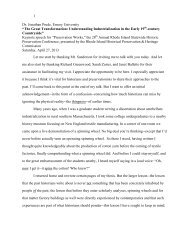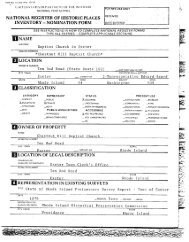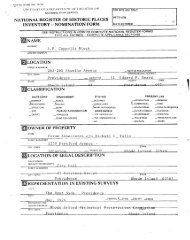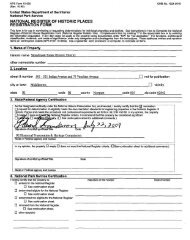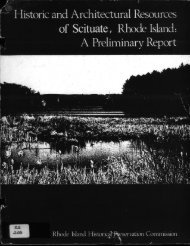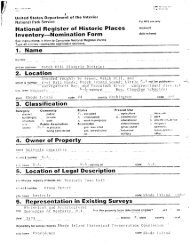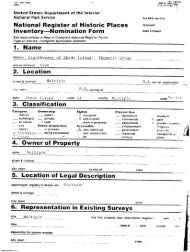National Park Service - Rhode Island Historical Preservation ...
National Park Service - Rhode Island Historical Preservation ...
National Park Service - Rhode Island Historical Preservation ...
You also want an ePaper? Increase the reach of your titles
YUMPU automatically turns print PDFs into web optimized ePapers that Google loves.
0MB IC 1024 0018<br />
NPS Form 10-900-i Exp- 10-31-84<br />
3-82 -<br />
United States Department of the Interior<br />
<strong>National</strong> <strong>Park</strong> <strong>Service</strong> -<br />
<strong>National</strong> Register of Historic Places<br />
Inventory-Nomination Form -<br />
Continuation sheet 16 - Item number 7<br />
Page 17<br />
incorporated the firm as the Peace Dale Manufacturing Company in<br />
1848 and began production of high-quality woolens in 1849. They<br />
made shawls, which gained wide renown, in place -of the kersey<br />
cloth and linsey-woolsey formerly produced. Manufacturing<br />
capacity was- greatly increased in 1856, with the construction of<br />
a-new and larger stone factory 37E. It was on of two buildings<br />
designed that year for the company by Rowland G. Hazard’s son,<br />
owland Hazard II, a latter-day gentleman architect. Most of the<br />
- later buildings in the mill complex are either known to be his<br />
work or are attributed to him.<br />
In 1868 a stone finishing plant was erected. In 1872 the<br />
Peace Dale Manufacturing Company again changed its product line,<br />
converting to worsteds, becoming one of the first full-production<br />
worsted plants in the country. - A new stone mill went up 37F<br />
from Rowland Hazard II’s plans. A major wing 37C was added to<br />
the first stone mill and that 1847 structure 37B was radically<br />
reduced in size. Only the stair tower, belfry, and stepped end<br />
gable remain; they were preserved, consciously, as a monument to<br />
the firm’s early history. In the mid-187Os a small stone<br />
laboratory building went up 37D and in 1881 a small yet<br />
imposing brick-trimmed stone mill office 37A was erected. It<br />
is believed the grouping of stone dye houses 37J was also<br />
constructed in the 1880s, as well as the stone weave shed 37G.<br />
The brick portions of the power plant 371 date to the 18908,<br />
- and two wool warehouses 37K and 37L date to about 1900.<br />
Because a network of waterways crisscrosses the mill yard,<br />
there has always been a need for bridges facilitating internal<br />
transportation and linking the mills to Kingstown Road and<br />
Columbia Street. None of the small nineteenth-century bridges<br />
within the mill complex survives. They have been replaced<br />
sympathetically by a half-dozen timber spans bridging the<br />
Saugatucket River and the mill race.<br />
A perspective view of the.mill complex published in 1901<br />
shows the Peace Dale plant at its fullest development and reveals<br />
that it remains essentially intact. The most significant changes<br />
since 1901 aside from the demolition of secondary structures<br />
noted above involved the reworking of the roofs of the worsted<br />
mill and weave shed 37F and 370. In the past twenty years new<br />
- owners have re-landscaped the most visible portions of the mill<br />
yard. This embellishment recalls the late nineteenth-century<br />
greening of the factory complex when the Peace Dale Mills were<br />
ivy-decked and surrounded by small lawns and great elms.







